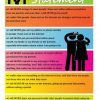Self-assessments, exercises and educational hand-outs to help teenagers stay safe
Being a teenager has always been challenging, but today teenagers face issues that have been compounded by a rapidly changing society and a plethora of technology. These changes require new strategies in ways to teach teenagers to protect themselves from the challenges they will constantly face in school and community, and with their friends and family.
Some of the areas in which teenagers need to worry about their personal safety include:
- Risks related to violence including bullying, exposure to gangs, and harm from guns and other weapons
- Online dangers including harassment, cyber-bullying, sexually explicit materials, identity theft and financial theft and scams, and agreeing to meet strangers in person after developing online relationships
- Victimization of crimes
- Risks while driving in dangerous ways, including driving after drinking or taking drugs, underestimating dangerous road situations, texting or using cell phones inappropriately and not wearing seat belts
- Putting themselves in personal danger by pressures to do things they do not want to do such as experimenting with drugs and alcohol, having unprotected sex, going to unsafe places by themselves and engaging in risky behaviours.
For teenagers, staying safe is a much more difficult task than in the past. To help teenagers sharpen their awareness of the need and ways to stay safe, the Teen Safety Workbook will guide them as they explore situations fraught with danger and face people who may threaten their safety.
During adolescence, teenagers are eager to press to become more independent from their parents, caregivers or family. They need to learn to be more responsible for their own safety. Regardless of whether they are at home, school, work, or in the community, or online, they must face great safety hazards and need to be aware of them. Teenager’s judgment levels are still forming; most are not ready to make adult level decisions. It is vital for teenagers to learn that they have the power to keep themselves safe and to be equipped with the tools to overcome dangerous situations.
The Teen Safety Workbook is designed to help teenagers engage in self-reflection, examine their thoughts and feelings that go into the decisions they make, and learn effective tools and techniques to stay safe in the future. This book combines two powerful psychological tools for the management of unsafe, potentially dangerous thoughts, feelings, and behaviours: self-assessment and journaling.
The Teen Safety Workbook contains five separate sections to help the participants learn more about the choices they have made and the choices they have yet to make in their lives:
- Positive Feelings Scale helps teenagers explore the negative feelings they are experiencing in life and learn effective methods to constructively express their emotions
- Healthy Choices Scale helps teenagers explore how healthy or unhealthy their lifestyle choices are
- Social Media Safety Scale helps teenagers explore safe behaviours while texting, chatting, using social media sites, and surfing the Internet
- Relationship Safety Scale helps teenagers explore the safety in their family, friendships, and dating relationships
- Self-Harm Scale helps teenagers explore the extent to which they deliberately harm themselves in attempts to cope with intense, overwhelming emotions.
Enrichment activities at the end of each chapter are a third tool for facilitators of teenagers from families struggling with substance abuse.
Age: 11-19
132 pages
Only logged in customers who have purchased this product may leave a review.
Related Products
LOGGERHEAD PUBLISHING
Counselling and CBT
Feelings & Emotions
LOGGERHEAD PUBLISHING
Personal Safety
Personal Safety
Abuse & Domestic Violence
Personal Safety
Counselling and CBT














Reviews
There are no reviews yet.